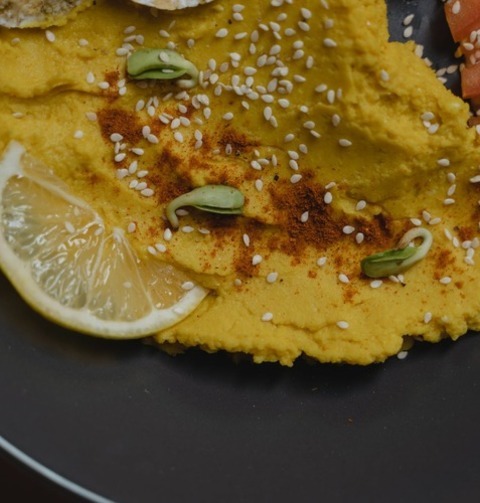#Puree with Chickpeas
Explore tagged Tumblr posts
Text
How to make Chickpea and Chicken Stew with Two Serving Options
Chickpeas are a fantastic source of fiber and flavor. I used to enjoy them solely in simit with chickpea flour from a local bakery, but now I’ve expanded my cooking to include this delicious recipe. It can be served as a hearty stew or a creamy puree. Here’s how to make it: Ingredients: 200 gr of chickpeas300 gr chicken fillets2 carrots1 branch of celery1/2 onion1 leek5 cloves garlic1 red sweet…
#homemade#Cómo hacer garbanzos con pollo#Chicken And Chickpeas#chicken recipe#Chickpea Recipes#comfort food#cooking at home#Delicious Puree#food recipe#Foodie Favorites#From Scratch Cooking#Gourmet Chickpeas#Healthy Cooking#healthy eating#homemade food#Homemade Meals -#homemade recipes for children#Homemade Stew#How to make Chickpeas with chicken#meat recipe#Nutritious Meals#Plant Based Delight#Puré de Garbanzos#Puree with Chickpeas#receta de carne#receta de comida#receta de pollo#receta para niños#recipe for children#Recipe Of The Day
0 notes
Text



Intersected flip!
A flip whose fliphood influences either or both their regression and caregiving. This flip may feel like they channel juvenility, playfulness and an essance of responsibility. This can be a sepperate "flip" headspace or be brought into their regression/caregiver headspace. Intersected flips may share a similar energy to kids entertainers/characters that are depectied an adult, but are scripted in a way that's more relatable and fun for children.
Magenta: Playfulness
Red: Compassion
Teal: Liveliness and energy
Green: Mental health, wellbeing and wholeness
Yellow: Youthfulness, spontaneity and charisma
Template found here Original flip flag by @heartbeathare
#agere flags#flip flags#age regression flags#caregiver flags#flip flag#chickpea originals#agere flag#If anyone wants to adjust the colours I'm all for it!#PLEASE tag me in stuff you make with any of my flags not purely for credit but it would make me SO happy
27 notes
·
View notes
Text
bruschetta with chickpea puree

0 notes
Text
Chickpea and sucuk stew
#middle eastern#turkish#chickpeas#sucuk#chorizo#tea#tomato puree#mint#yoghurt#bulgur wheat#cous cous#rice#flatbread#pita
0 notes
Text
Pumpkin and Sesame Seed Hummus

Pumpkin and Sesame Seed Hummus. Garlic Cloves, Tahini, Olive Oil, Sesame Seeds, Ground Cumin, Lemon Juice, Ground Coriander, Salt, Pumpkin Puree, Chickpeas. This pumpkin and sesame seed hummus is a tasty fall twist on the traditional dip. It's creamy and flavorful, making it ideal for snacking or as a party appetizer.
0 notes
Text
This gluten-free snack is a unique twist on the traditional hummus. Perfect for Halloween!
#foodblogger#therecipetobeornottobe#foodporn#foodie#foodista#foodlover#instafood#foodgasm#food photos#food recipes#snack food#snack#hummus#pumpkin hummus#chickpeas#pumpkin puree#lemon#lemon juice#salt#kosher salt#garlic#lemon zest#tahini#cayenne pepper#halloween food#halloween#creamy#glutenfree#scrumptious
0 notes
Text
Pumpkin and Sesame Seed Hummus

Pumpkin and Sesame Seed Hummus. This pumpkin and sesame seed hummus is a tasty fall twist on the traditional dip. It's creamy and flavorful, making it ideal for snacking or as a party appetizer.
0 notes
Text

For Christmas I got Portico by Leah Koenig, which is a book of both recipes and essays about the culture of the Jewish community in Rome; I used recipes from Portico to cook my New Year's feast in 2023, but I didn't own a copy until now. I've been selecting recipes I want to try, and I had most of the ingredients for this one so it came first -- this is Pasta e Ceci, chickpea stew. You simmer chickpeas in a sauce of seasoned diluted passata (strained tomato puree) and then mash some of the chickpeas to thicken the stew, adding pasta (in this case ditalini) towards the end.
I made some modifications -- I added some meatballs I'd made last week, and when I tasted it at the end I felt it needed a little herbal sharpness so I added some shredded basil. It's very simple and filling, sort of like a less sweet baked bean dish, and this amount (a halved recipe) will probably feed me for a week. Next time I might add some caramelized onions, and while the recipe calls for water to be added to the passata I think probably replacing half the water with red wine would add a nice depth to it.
165 notes
·
View notes
Text
just remembered i have to suffer through ezria again and now i’m wondering if it’s even worth it
it’s that time of year again (time to rewatch pretty little liars for the millionth time)
#fills me w pure anger i hate you ezra fitz#and now i’m thinking abt the chickpeas and i literally can’t keep a straight face
2 notes
·
View notes
Text
I had a long boring mandatory work event today, which means I spent a lot of time at The Turnspit Dog.
The Turnspit Dog is my imaginary neighborhood farm-to-table restaurant. (NB: I have no desire to run an actual restaurant, which involves doing things like "cooking whether I or not I feel like it" and "making a profit." This is a purely imaginary affair.)
At any rate. This week, The Turnspit Dog is offering a roasted red pepper soup with toasted chickpeas and cashew crema or a chicken elote soup with sweet corn and red potatoes; a roasted broccoli salad with almonds and pickled carrots, as well as the usual house green salad; buccatini a la Norma (with eggplant and ricotta salata); a slow-cooked pork shoulder with polenta, grilled broccolini, and apple cider gastrique; a bisteyya (phyllo chicken pie with cinnamon) with plum compote; a white bean stew with fennel and confit plum tomatoes, braised kale, and sourdough croutons; a tipsy peach upside-down cake; and oat milk black walnut ice cream with brandied cherries.
It was a long work event.
76 notes
·
View notes
Text
Saving this for me. Items possibly targeted for tariffs.
Saving this for me. Items possibly targeted for tariffs. • Bananas, Mangoes, and Pineapples (from Central and South America) • Avocados (from Mexico) • Citrus fruits like oranges and lemons (from Mexico and Spain) • Berries (e.g., strawberries, blueberries) (from Mexico, Chile) • Tomatoes, Bell Peppers, and Cucumbers (from Mexico and Canada) • Asparagus (from Peru and Mexico) Seafood (Fresh, Frozen, and Canned) • Fresh/Frozen Shrimp (from Thailand, India, Ecuador) • Salmon (from Norway, Chile) • Tilapia (from China) • Tuna (canned) (from Thailand, the Philippines) • Sardines (from Portugal, Morocco) • Mackerel (canned) (from Japan, Norway) Grains and Legumes • Rice (from Thailand, India, Vietnam) • Quinoa (from Peru and Bolivia) • Chickpeas and Lentils (from Canada, India) Nuts and Seeds • Cashews (from Vietnam and India) • Brazil Nuts (from Bolivia, Brazil) • Almonds (from Spain, Australia) • Chia Seeds (from Mexico and Argentina) Dairy Products • Cheese varieties like Parmesan, Gouda, Feta (from Italy, Netherlands, Greece) • Butter (from Ireland, New Zealand) • Yogurt (Greek-style from Greece, other varieties from Europe) Canned Foods and Packaged Items • Tomato paste and puree (from Italy) • Canned olives and olive oil (from Spain, Italy, Greece) • Canned coconut milk (from Thailand) • Canned beans (from Mexico, Central America) • Canned corn (from Canada, Brazil) • Canned anchovies and sardines (from Morocco, Portugal) • Canned fruit (e.g., pineapple, mango, peaches) (from Thailand, Philippines, Mexico) • Canned tuna and salmon (from Thailand, the Philippines, Chile) Spices and Herbs • Vanilla (from Madagascar) • Black Pepper (from Vietnam, India) • Cinnamon (from Sri Lanka) • Turmeric (from India) • Paprika (from Spain, Hungary) Beverages • Coffee beans (from Brazil, Colombia, Vietnam) • Tea leaves (from India, Sri Lanka, China) • Cocoa beans (from Côte d’Ivoire, Ghana) Oils and Fats • Olive oil (from Spain, Italy, Greece) • Coconut oil (from the Philippines, Indonesia) • Palm oil (from Malaysia, Indonesia) Alcoholic Beverages • Wine (from France, Italy, Chile, Spain) • Beer (particularly certain Mexican brands) • Whiskey and Scotch (from Scotland, Ireland) Sweeteners • Cane sugar (from Brazil, Mexico) • Maple syrup (from Canada) Condiments and Sauces • Soy sauce (from Japan, China) • Fish sauce (from Thailand, Vietnam) • Sriracha and other chili sauces (from Thailand) • Italian pasta sauces (canned/jarred) (from Italy)
83 notes
·
View notes
Text
Lamb tagine
#tea#moroccan#lamb#lamb leg#carrot#tagine paste#tinned tomatoes#tomato puree#lamb stock#lentils#chickpeas#broccoli#coriander#mint
0 notes
Text
Yeah bitch

Goddamn it I’m hyping myself up for the dinner I have planned WAY too early in the day
#I made a quick yogurt-lemon-dill sauce to go w it. plus a little sriracha. and a little pickle relish bc the acid is good#note to self spices were perfect this time round; minced garlic and egg puree with chickpeas then mix in bowl w salt pepper paprika dill dri#dried chives shawarma seasoning olive oil about an 8th cup of flour and panko to texture
6 notes
·
View notes
Text
You know what, I crave to try new things and so I wanna start a tag game
Tag 5 blogs and share your go-to recipe(s) you cook regularly that you think more people should try
You can type or link a recipe, use whatever way you prefer. Doesn't have to be a meal, could be a drink or a snack or something. No pressure to participate.
@tartrazeen @unlisshed @alcatrazoutpatient @justanotherhumblebagel @heyyjae @feltsticker @kishavo @nothinggathers @senorpugbean @verved @radibe5 (I'm tagging a whole lot of you, sorry) and feel free to participate everyone who sees this post and feels like it
I've already shared mine on multiple occasions (hi @tartrazeen) , but I'll do it again before I love dal and I can't really think of anything else to share (that's why I'm making it!)
Ingredients in the order of how they're added, orange ones are the ones I always add and consider essential, blue are optional. No precise measurements because I never measure it and just do how I feel like. This dish can be prepared in so many different variations you really can't get it wrong, it'll always end up delicious
Some oil or butter heated in a pot
Some cumin seeds added to the pot and heated
One diced onion. I usually have red ones but use whatever you prefer, whatever size you like. Fried until translucent before adding next ingredient
Garlic and/or ginger. Can be freshly diced/grated or can be premade paste. I add both in paste because it's convenient and easy
Chilli/Jalapeño peppers if you have any and like it spicy
A can of chickpeas (some variations of this dish don't have chickpeas in it but I always add them in mine)
Garam masala spice mix (I don't remember the exact content of what's in it)
Two-three diced tomatoes or a can of tomatoes of you're feeling lazy/don't have fresh tomatoes
Additional tomato paste/puree
Additional veggies if you want/need to use them. Pretty much anything will do, but I enjoy cauliflower the most, and if you make it more like a soup with more water in it, potatoes can be nice addition
Lentils (I use regular red ones + I add some moong dall chilka just because I can)
Water + bouillon cube (any) or just salt if not
(now just put a lid on and cook it until lentils are ready. Mix once in a while or add more water of it's getting too thick for your taste)
Greens like spinach or parsley if you have/want them
A can of coconut milk is optional but really nice addition + it can help if you accidentally made it too spicy
More greens (like parsley or coriander)
If you didn't use coconut milk, you can enjoy it with sour cream or some plain yogurt or without
I guess you can also add lemon/lime juice but tbh I've never done this
Enjoy!
26 notes
·
View notes
Text


OWL GIFTS for Inspired_Being!
GET A RECIPE on AO3: Promising Baker [podfic] read by: Smirkingcat* Podficced Work: Promising Baker by Inspired_Being Summary: Harry didn’t get to bake at the Dursley's so it was one thing in the kitchen that wasn't tainted. After the war, he started the tradition of making shortbread for everyone at Christmas. For their first Christmas as a couple, Draco may have joked they should do the baking together. Harry may have tricked him into promising. Podfic Length: 15:55 min Music by Clavier-Music, Song Evening Snowfall - Soft Winter Piano Music Podfic Cover: Smirkingcat Rating: Teen Contains: Fluff, Baking, Established Relationship Notes: First thanks to our amazing mods who both had the patience of a rock with me, who was unable for the first time to really deliver on time – THANK YOU BOTH SO MUCH! Dear Inspired_Being, I hope you are doing good <3 we are both so busy, which lead to us less talking, but I was so excited when I saw you were my giftee and I got to record another story for you. Sadly Christmas season is pure hell for me, so I knew it had to be something short (and it still was super late because throat sickness as every year :D") but as I felt so much like Harry and could resonate with him so much I knew it had to be this one. Merry Christmas and a very happy new year, and maybe we will find some time to chat it up again <3
READ on AO3: Nights like these Summary: After a Quidditch game in the cold, freezing winter weather, Harry is in a foul mood. Can Draco help cheer him up? Word Count: 1,690 Rating: G Contains: Annoyed Harry, Quidditch talk and hot chocolate that warms you right up! Notes: I hope you'll enjoy this little piece, Inspired! It was fun to write for you ❤️
WATCH A HIPPOGRIFF on AO3: A Hippogriff For Christmas [podfic] read by: @uncannycerulean Podficced Work: A Hippogriff For Christmas by @Xanthippe74 Summary: Draco is desperately trying to fulfil four-year-old Scorpius’ dearest wish for Christmas: a visit with a real Hippogriff. Harry is desperately trying to be left alone, safely tucked away from the attention of the wizarding world as Hogwarts’ Keeper of the Keys and Grounds. It might take more than a father’s persistence to convince Harry to help make Scorpius’ Christmas dream come true. Podfic Length: 39 min 54 s Rating: G Notes: Happy Holidays, Inspired_Being! I hope you enjoy this podfic version of one of my favourite Christmas fics. Many thanks to the author, Xanthippe74, for giving me permission, and to Lani and Chickpea for their invaluable advice.
10 notes
·
View notes
